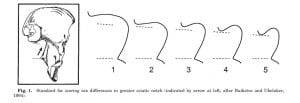A binary system is one which has two answers: 0 or 1, yes or no, female or male. In western cultures sex and gender are of ten considered binary. This is not accurate. Before going into the nonbinary systems that exist in both sex and gender, it is important to differentiate between the two. Sex is the genetic identity that is based on chromosome. The most common categories for sex are male (XY) and female (XX) and traditionally it is accepted that sex is binary. Gender is the socially constructed roles that people are expected to follow. In western cultures like our own, these are feminine and masculine or girl or boy. They are generally based on our sex (or how our sex is presented physically) and we are trained from birth to follow those roles. Baby boys are represented by blue and are given trucks, dinosaurs, and action figures to play with. Girls are represented by pink and given make-up, domestic themed toys, and dolls to play with. In fact, when someone has a child, the first question is often is it a boy or a girl? There are large social impacts that this binary system has on people but that is for a different discussion. This post will focus on the forensic and archaeological implications of assuming binary when examining skeletal remains.

This task force aims to solve cold cases that contain trans or nonbinary individual (http://transdoetaskforce.org/)
In a survey conducted this year on forensic anthropologists showed that 30% of them had handled transgender cases and 42% considered sex binary (TRANScending Jane and John Doe). The problem with considering sex to be binary is that it ignores the 2% of people who are intersex which occurs when an individual has a different chromosomal pattern than XY or XX such as

Intersex flag (https://pridenation.lgbt/)
XO or XXX. The forensics and medical system consider intersex as a pathology or non-normal condition. This designation is problematic because it puts that sex on the backburner. Pretty much all studies regarding sex estimation do not even consider intersex to be a category. 2% of the population seems pretty small but that is also the percentage of natural redheads which is not considered a pathology but a viable and normal hair color. In a forensic sense, only designating an individual as male or female and not even considering gender, could easily prevent their identification. The Trans Doe Task Force and a few other organizations work on cases (specifically cold cases) that involve individuals who do not conform to our binary system. They attempt to correct gender categorizations in the forensic documentation and aid in the identification and resolution of the case.
The consideration of nonbinary gender and sex extremely important in forensics but also in archaeology. Too often to archaeologists impose their own binary system of gender and gender roles onto past cultures. This assumption of customs severely hinders the accuracy of the interpretation and makes cases of obvious nonbinary burials or lifestyles seem abnormal. Many cultures around the world have more than one gender. In some Native American cultures intersex or nonbinary individuals were considered to have two-spirits and many have specific names and roles for those people. When examining burials, it is important to consider not only the sex characteristics of the skeleton but also the context in which the individuals was buried. And the sex of the skeleton does not always indicate the gender of the individual.

Sex estimation scoring system for the pelvis (Walker 2005)
Sex estimations using skeletal remains are also rather variable and not as binary as one might think. Each trait has varying levels of masculinity and femininity and even the designations consist of male, probable male, indeterminate, probable female, and female. I personally saw some of the contradictions and variations of sex estimations in my thesis collection. Some individuals have crania that were quite gracile (likely indication a female) but the pelvis was quite distinctly masculine. Not all traits examined will agree and that determination does not always indicate their place in society. Gender cannot be determined by the skeleton and in cases of intersex individuals, sex might not even be determinable. Because of the prevalence of nonbinary individuals throughout history, new methods of estimating sex need to consider the possibility of intersex and also gender nonbinary systems when interpreting remains. As well, archaeologists and other researchers need to be aware of their own biases when interpreting gender roles of past cultures.
Follow IUP Anthropology on Facebook, Twitter, and Instagram
Sources: TRANScending Jane and John Doe
Geller, Pamela L.
2005 Skeletal Analysis and Theoretical Complications. World Archaeology 37(4): 597-609
Jones, Greyson
2014 Not a Yes or No Questions: Critical Perspectives on Sex and Gender in Forensic Anthropology. MA Thesis. Department of Sociology, Anthropology, and Criminology, University of Windsor, Ontario.